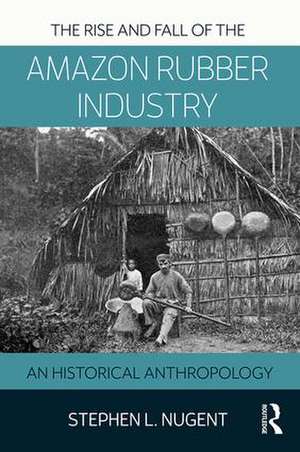The Rise and Fall of the Amazon Rubber Industry: An Historical Anthropology
Autor Stephen Nugenten Limba Engleză Paperback – 5 dec 2017
| Toate formatele și edițiile | Preț | Express |
|---|---|---|
| Paperback (1) | 362.28 lei 6-8 săpt. | |
| Taylor & Francis – 5 dec 2017 | 362.28 lei 6-8 săpt. | |
| Hardback (1) | 992.90 lei 6-8 săpt. | |
| Taylor & Francis – 5 dec 2017 | 992.90 lei 6-8 săpt. |
Preț: 362.28 lei
Nou
Puncte Express: 543
Preț estimativ în valută:
69.38€ • 71.48$ • 58.12£
69.38€ • 71.48$ • 58.12£
Carte tipărită la comandă
Livrare economică 24 februarie-10 martie
Preluare comenzi: 021 569.72.76
Specificații
ISBN-13: 9781138894037
ISBN-10: 1138894036
Pagini: 224
Ilustrații: 30 Line drawings, black and white; 17 Halftones, black and white; 3 Tables, black and white; 47 Illustrations, black and white
Dimensiuni: 156 x 234 x 19 mm
Greutate: 0.34 kg
Ediția:1
Editura: Taylor & Francis
Colecția Routledge
Locul publicării:Oxford, United Kingdom
ISBN-10: 1138894036
Pagini: 224
Ilustrații: 30 Line drawings, black and white; 17 Halftones, black and white; 3 Tables, black and white; 47 Illustrations, black and white
Dimensiuni: 156 x 234 x 19 mm
Greutate: 0.34 kg
Ediția:1
Editura: Taylor & Francis
Colecția Routledge
Locul publicării:Oxford, United Kingdom
Public țintă
PostgraduateCuprins
Preface: The Amazon Rubber Boom, Tapping into the Past 1. Requiem for the Amazon Rubber Boom 2. This Substance Called Rubber: Hevea and Its Relations 3. Anthropological Rubber in the Amazon 4. Postcards from El Dorado: an overview of historical accounts of the rubber industry 5. Embedded Tropes and the Shift of Time 6. Failure as a Stage of Modernization, Part one: Narratives of failure 7. Failure as a Stage of Modernization, Part two: Modernity redux, the failure of Fordlândia 8. After the Wild Frontier 9. The Melancholy and the Modern 10. Rubber in London 11. Concluding Comments
Notă biografică
Stephen L. Nugent is Professor of Anthropology in the Department of Anthropology at Goldsmiths, University of London, UK.
Recenzii
“As Sidney Mintz does with sugar, Nugent does with rubber. This is the story of a product tapped by Amazonian labourers that led to industrial expansion in the late nineteenth and early twentieth centuries. Illustrated with contemporary images, adverts and maps, the study is a treasure chest of a book. It reminds the reader of the value of an historical anthropology to examine the connections between workers, traders, capitalists, scientists and consumers in different corners of the globe. Yet this book is fundamentally about the Amazon, its people and their contribution to the modern world.”
Mark Harris, University of St Andrews, UK
“Meticulously researched and rigorously argued, this book rethinks the connections between extraction of natural rubber by peasant producers in Amazonia, international trading, and capitalist industry in London. Bringing local production relations into view underpins a powerful critique of rubber “boom and bust” thinking and continuing naturalization of Amazonian “development challenges.””
John Gledhill, The University of Manchester, UK
Mark Harris, University of St Andrews, UK
“Meticulously researched and rigorously argued, this book rethinks the connections between extraction of natural rubber by peasant producers in Amazonia, international trading, and capitalist industry in London. Bringing local production relations into view underpins a powerful critique of rubber “boom and bust” thinking and continuing naturalization of Amazonian “development challenges.””
John Gledhill, The University of Manchester, UK
Descriere
Examining rubber in the Amazon from the perspective of a long-term (one hundred years) extractive industry that linked remote forest tappers to technical innovations central to the industrial transformation of Europe and North America, the book emphasizes the links between the social landscape of Amazonia and the global economy. This book should be required reading for all those interested in the Amazon, and will be relevant to scholars of anthropology, political ecology, geography, history of Latin America, the industrial revolution, and development studies.
